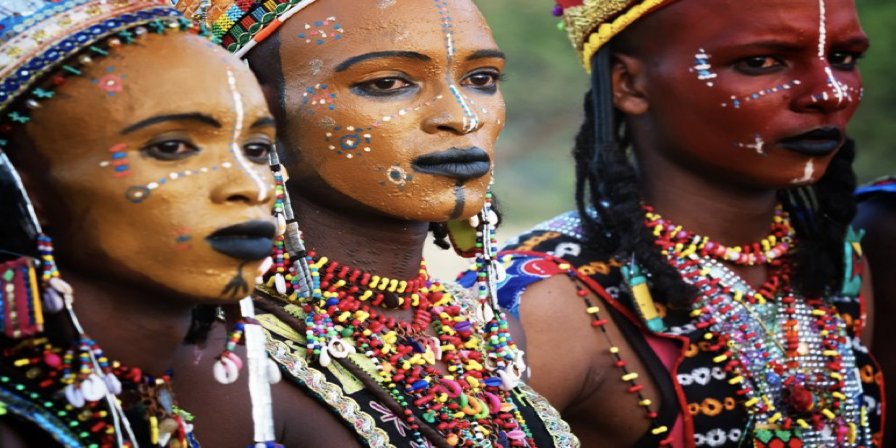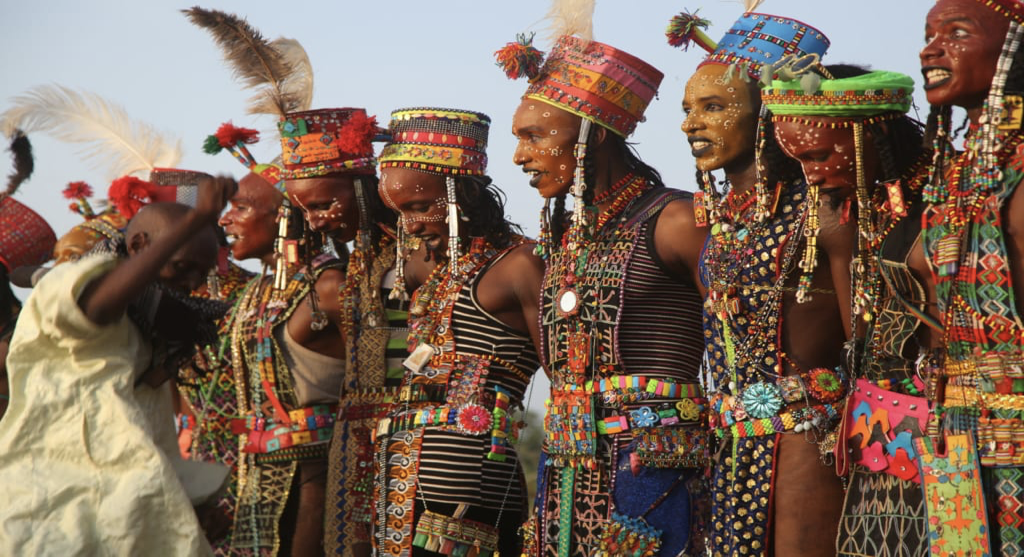The Wodaabe Wife Stealing Festival, also known as Guérewol, is an annual courtship ritual competition celebrated among the Wodaabe Fula people of Niger. This unique festival showcases the rich cultural heritage of the Wodaabe community and provides a platform for young men to vie for the attention of marriageable young women. The festival is a colourful and lively event, featuring dance, song, elaborate ornamentation, and traditional face painting. Let’s delve deeper into the significance, customs, and cultural context of the Wodaabe Wife Stealing Festival.
The Wodaabe, also known as the Mbororo or Bororo, are a subgroup of the Fula ethnic group, traditionally nomadic cattle herders inhabiting regions across Niger, Cameroon, Central African Republic, Chad, Nigeria, and the Democratic Republic of Congo. With a population of approximately 100,000, the Wodaabe maintain a distinctive cultural identity and are recognized for their resilience, resilience, and cultural traditions.
The Guérewol festival is a celebration of beauty and courtship. It is a vibrant and lively event that showcases the Wodaabe men’s charm and elegance as they vie for the attention and affection of marriageable young women. The festival occurs when the traditionally nomadic Wodaabe cattle herders gather at the southern edge of the Sahara before dispersing south to their dry season pastures. The most famous gathering point is In-Gall in northwest Niger, where a large festival, market, and series of clan meetings take place for both the Wodaabe and the pastoral Tuareg people.
During the Guérewol, the Wodaabe men adorn themselves in elaborate ornamentation, wear traditional face paint, and dress in their most extravagant attire. They form lines and dance to showcase their physical beauty, charm, and vitality. The dance is accompanied by rhythmic songs and chants, creating an electrifying atmosphere. The young men strive to outshine one another, hoping to be chosen by the young women as potential suitors.

The Wodaabe women play a crucial role in the festival as they observe the performances of the men. They meticulously evaluate their beauty, grace, and stamina. The women make their selection based on various criteria, including physical attractiveness, dance skills, and overall appeal. Once a woman chooses a man, she notifies him by rolling her eyes upward, a gesture known as “shooting the eye.” This signals her interest and prompts further courtship rituals.
It is important to note that the term “wife stealing” used to describe the festival can be misleading. The festival does not involve the actual act of abduction or non-consensual marriage. Instead, it is a symbolic representation of courtship and marriage rituals within the Wodaabe culture. The term “wife stealing” is derived from Western interpretations and may not accurately depict the cultural nuances of the Wodaabe people.
The Wodaabe Wife Stealing Festival bears similarities to other cultural practices, such as bride kidnapping, found in various parts of the world. However, it is essential to distinguish between these practices. Bride kidnapping typically involves the non-consensual abduction of women, while the Guérewol is a consensual and symbolic courtship ritual. The festival showcases the agency of Wodaabe women in choosing their potential partners, highlighting their active role in the process.
The Wodaabe Wife Stealing Festival reflects the cultural values and traditions of the Wodaabe people. It is a celebration of beauty, courtship, and the agency of women. The festival allows young Wodaabe men and women to engage in a vibrant display of their cultural identity and heritage. It also serves as an opportunity for the Wodaabe community to come together, socialize, and reinforce their cultural bonds
Courtship and Mate Selection
The Guérewol Festival serves as a courtship platform, allowing young Wodaabe men to exhibit their desirability and court the attention of young women. While the festival is often referred to as the “Wife Stealing Festival,” it is essential to understand that the term is symbolic rather than literal. The term refers to the competitive nature of the festival, where men strive to attract the attention and affection of women, with the ultimate goal of establishing meaningful relationships and initiating marriages.
The festival also provides an opportunity for families to assess potential suitors for their daughters. They observe the performances and interactions between young men and women, considering factors such as physical appearance, charisma, reputation, and family background. Although the final decision lies with the young women and their families, the Guérewol Festival greatly influences the mate selection process within the Wodaabe community.
Cultural Significance

The Wodaabe Wife Stealing Festival, or Guérewol, is deeply rooted in the cultural fabric of the Wodaabe community and holds significant importance for several reasons:
- Cultural Preservation: The festival serves to preserve and celebrate the unique cultural heritage of the Wodaabe people. It provides a platform for the passing down of traditions, knowledge, and values from one generation to the next. Through the festival, Wodaabe youth learn about their cultural roots, traditional practices, and the importance of community cohesion.
- Social Cohesion: The Guérewol Festival brings together the entire Wodaabe community, fostering a sense of unity and belonging. It is a time when families, extended relatives, and clans reunite, strengthening social bonds and promoting communal harmony. The festival provides an opportunity for socialising, storytelling, and sharing experiences, reinforcing the collective identity of the Wodaabe people.
- Courtship and Marriage: The festival plays a pivotal role in the courtship and marriage traditions of the Wodaabe. It allows young men to showcase their physical attractiveness, talents, and personalities, thereby increasing their chances of finding suitable partners. It also enables families to assess potential suitors and negotiate marriage alliances. The festival acts as a catalyst for the formation of new relationships, promoting social stability within the community.
- Beauty Standards and Individual Expression: The Guérewol Festival celebrates the Wodaabe ideal of beauty. Participants engage in intricate face painting, elaborate jewellery, and vibrant costumes, emphasising physical attractiveness and personal expression. The festival highlights the cultural significance of beauty and serves as a platform for individuals to showcase their creativity and individuality.
- Cultural Exchange: The Guérewol Festival attracts visitors from neighbouring communities, fostering cultural exchange and interaction. It provides an opportunity for the Wodaabe people to share their traditions, music, dances, and craftsmanship with outsiders, promoting cross-cultural understanding and appreciation.
- Tourism and Economic Opportunities: The festival has gained international recognition and attracts tourists who are interested in experiencing and learning about the unique Wodaabe culture. This influx of visitors contributes to the local economy through the sale of handicrafts, traditional artefacts, and local products.
Ultimately, The Wodaabe Wife Stealing Festival, Guérewol, is much more than a mere courtship ritual. It represents the cultural identity, social cohesion, and rich traditions of the Wodaabe people. By providing a platform for courtship, marriage negotiations, and the celebration of beauty, the festival plays a crucial role in maintaining the cultural fabric of the Wodaabe community. It serves as a vibrant testament to the resilience, pride, and cultural heritage of the Wodaabe people, contributing to their collective identity and promoting the intergenerational transmission of customs and values.
Sources




